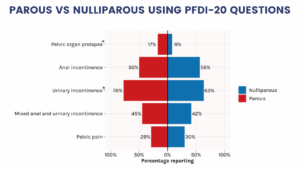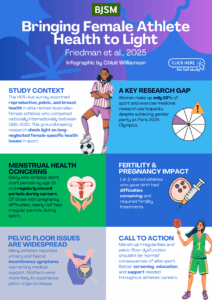Why is this study important?
Women have been competing in elite sport for centuries. Although more women and girls are competing than ever before – with gender parity finally achieved at the Paris 2024 Olympics – research has not kept pace. Over the last decade, women made up only about 10% of all participants in sport and exercise medicine research, and this number has barely changed.
It is therefore not surprising that we still know too little about how elite sport affects female athlete health, especially once retired and out of the high-performance sporting system. Most of what we do know about long-term female athlete health is based on research in males. But female athletes face unique health challenges across all life stages, including the effects of intense training on menstrual health, pregnancy, pelvic floor function, and breast health.
Without exploring the lived experiences of female athletes throughout their careers and into retirement, we limit the development of evidence-based care and effective health protection strategies. This knowledge and implementation gap contributes to many missed opportunities for health promotion, prevention and timely management – potentially negatively affecting performance and long-term quality of life.
How did the study go about this?
We invited elite retired Australian female athletes to complete an anonymous online survey about their health during and after sport. To be part of the study, athletes needed to have competed at the national or international level between 1981 and 2021, and be at least two years into retirement. The survey was co-created with current and former athletes and piloted by an athlete focus group to ensure questions were clear, relevant, and sensitive to athlete experiences.
The survey included nine different health domains comprising a mix of validated tools and expert-designed questions. For this study, we only analysed data from three key female athlete health domains: reproductive health, pelvic floor health, and breast health.
What did the study find?
- Many retired athletes reported not starting their period by age 15, as well as regularly missing periods during their sporting careers.
- Of athletes who reported pregnancy difficulties, nearly half reported regularly missing periods during their careers.
- Of athletes who gave birth, 1 in 5 had difficulties conceiving and required fertility treatments.
- Many athletes reported symptoms of urinary and faecal incontinence that would warrant further medical/physiotherapy support. Athletes who had given birth, were more likely to report symptoms of pelvic organ prolapse and urinary incontinence compared to those who had not.
- 1 in 5 retired athletes experience breast pain during exercise, but nearly all said it never impacts them from being active.

What are the key take-home points?
In a sport and exercise medicine ecosystem that lacks sex and gender parity, female-specific health domains are often considered taboo and have historically been neglected, leading to underreporting of symptoms and avoidance of screening.
There are multiple strategic timepoints throughout a female athlete’s career—such as entry into elite sport, during periodic health evaluations, and upon retirement —that offer valuable opportunities for screening and management of female-specific health issues.
Tangible steps like adding standard questions to health screenings, training clinicians, and educating athletes about topics such as energy deficiency, pelvic floor health, and bra fit can help break the stigma and support better performance and long-term health.
The high prevalence of menstrual irregularities and pelvic floor dysfunction we found should not be viewed as an acceptable consequence of elite sport. We need to better our understanding of health across the life course in all athletes so we can better support them from development pathways to life after sport.

Blog Author: Daniel Friedman